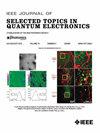双光子显微镜对光动力治疗大鼠食道损伤的分层分析
IF 5.1
2区 工程技术
Q1 ENGINEERING, ELECTRICAL & ELECTRONIC
IEEE Journal of Selected Topics in Quantum Electronics
Pub Date : 2025-07-30
DOI:10.1109/JSTQE.2025.3593926
引用次数: 0
摘要
食道的特点是多层结构,每一层的成分不同,导致光动力治疗(PDT)的层特异性损伤阈值。准确有效地评估每层健康组织的损伤是PDT治疗成功根除食道肿瘤的关键。然而,对每一层的损伤进行全面评估需要多种传统方法的整合,这既耗时又费力。本研究采用双光子显微镜(TPM)对PDT致全层损伤的大鼠食管切片和新鲜样本进行了成像。我们发现TPM能准确识别食管各层损伤,包括细胞增生、固有层脱离、胶原纤维疏松扭曲、肌肉纤维空泡化萎缩等,与传统方法检测结果一致。此外,TPM具有传统方法所不具备的独特能力。例如,TPM成功检测到坏死食管上皮细胞核周荧光增强,对胶原纤维变化进行定量分析,并实现了损伤引起的结构和形态改变的三维可视化。综上所述,我们的研究结果表明,TPM是评估PDT诱导的层特异性效应的有效工具,并有望对提高PDT在空心器官肿瘤治疗中的靶向准确性产生长期影响。本文章由计算机程序翻译,如有差异,请以英文原文为准。
Layered Analysis of Injury in the Rat Esophagus Induced by Photodynamic Therapy Using Two-Photon Microscopy
The esophagus is characterized by a multi-layered structure with compositional differences in each layer, resulting in layer-specific damage thresholds to photodynamic therapy (PDT). Accurate and efficient evaluation of the damages in each layer of healthy tissues is crucial for a successful PDT treatment when eradicating tumors in esophagus. However, conducting a comprehensive assessment of damage to each layer requires the integration of multiple traditional methods, which can be both time-consuming and labor-intensive. Here, we employed two-photon microscopy (TPM) to image rat esophageal sections and fresh samples with full-layer damage induced by PDT. We find that TPM can precisely identify injuries in each layer of the esophagus, including cellular hyperplasia, lamina propria detachment, loosened and tortuous collagen fibers, as well as vacuolated and atrophied muscle fibers, which are consistent with the detection results of traditional methods. Moreover, TPM possesses unique capabilities not present in traditional methods. For example, TPM successfully detected enhanced perinuclear fluorescence in necrotic esophageal epithelial cells, performed quantitative analysis of collagen fiber changes, and enabled three-dimensional (3D) visualization of structural and morphological alterations caused by the damage. Together, our findings demonstrate that TPM serves as an effective tool for evaluating layer-specific effects induced by PDT, and is expected to have a long-term influence for enhancing the targeting accuracy of PDT in tumor treatment of hollow organs.
求助全文
通过发布文献求助,成功后即可免费获取论文全文。
去求助
来源期刊

IEEE Journal of Selected Topics in Quantum Electronics
工程技术-工程:电子与电气
CiteScore
10.60
自引率
2.00%
发文量
212
审稿时长
3 months
期刊介绍:
Papers published in the IEEE Journal of Selected Topics in Quantum Electronics fall within the broad field of science and technology of quantum electronics of a device, subsystem, or system-oriented nature. Each issue is devoted to a specific topic within this broad spectrum. Announcements of the topical areas planned for future issues, along with deadlines for receipt of manuscripts, are published in this Journal and in the IEEE Journal of Quantum Electronics. Generally, the scope of manuscripts appropriate to this Journal is the same as that for the IEEE Journal of Quantum Electronics. Manuscripts are published that report original theoretical and/or experimental research results that advance the scientific and technological base of quantum electronics devices, systems, or applications. The Journal is dedicated toward publishing research results that advance the state of the art or add to the understanding of the generation, amplification, modulation, detection, waveguiding, or propagation characteristics of coherent electromagnetic radiation having sub-millimeter and shorter wavelengths. In order to be suitable for publication in this Journal, the content of manuscripts concerned with subject-related research must have a potential impact on advancing the technological base of quantum electronic devices, systems, and/or applications. Potential authors of subject-related research have the responsibility of pointing out this potential impact. System-oriented manuscripts must be concerned with systems that perform a function previously unavailable or that outperform previously established systems that did not use quantum electronic components or concepts. Tutorial and review papers are by invitation only.
 求助内容:
求助内容: 应助结果提醒方式:
应助结果提醒方式:


